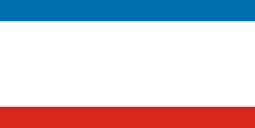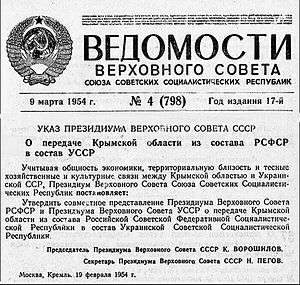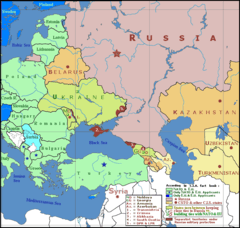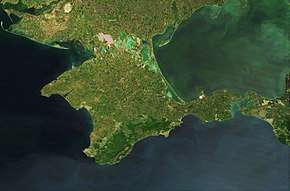Autonomous Republic of Crimea
The Autonomous Republic of Crimea (Ukrainian: Автономна Республіка Крим, Avtonomna Respublika Krym; Russian: Автономная Республика Крым, Avtonomnaya Respublika Krym; Crimean Tatar: Qırım Muhtar Cumhuriyeti) is, de jure, an autonomous republic of Ukraine encompassing most of Crimea that was annexed by the Russian Federation in 2014.
Autonomous Republic of Crimea
| |
|---|---|
 Flag
 Coat of arms
| |
Motto: "Процветание в единстве" (Russian) Protsvetaniye v yedinstve (transliteration) Prosperity in Unity | |
Anthem: "Нивы и горы твои волшебны, Родина" (Russian) Nivy i gory tvoi volshebny, Rodina (transliteration) Your fields and mountains are magical, Motherland | |
 | |
 Location of the Autonomous Republic of Crimea (light yellow) in the Crimean Peninsula | |
| Status | Autonomous republic |
| Capital and largest city | Simferopol |
| Official languages | Ukrainian, Russian, Crimean Tatar |
| Ethnic groups (2001) |
|
| Country | |
| Establishment | |
• Autonomy | 12 February 1991 |
• Official Ukrainian date of loss of control | 20 February 2014[nb 1] |
| 18 March 2014[2] | |
| Area | |
• Total | 26,100 km2 (10,100 sq mi) |
| Population | |
| 2,033,700 | |
• Density | 77.9/km2 (201.8/sq mi) |
| ISO 3166 code | UA-43 |
 Collage of Crimean culture | |
Crimea was historically under the control of the Russian Empire from 1783 to 1917 and Soviet Union from 1918 to 1991. Following the Russian Revolution of 1917 and the Russian Civil War (7 November 1917 – 25 October 1922), it was established in 1921 as the Crimean Autonomous Soviet Socialist Republic within the Russian Soviet Federative Socialist Republic in the USSR. During World War II, Crimea was downgraded to the Crimean Oblast after its entire indigenous population, the Crimean Tatars were deported to Central Asia, an act recognized as a genocide by Ukraine and 3 other countries. In 1954, it was transferred to the Ukrainian SSR from the Russian SFSR. Later, following a referendum on 20 January 1991, it was upgraded to the status of an autonomous republic within the Ukrainian SSR. When the Soviet Union collapsed in 1991 and Ukraine became an independent country, Crimea remained part of the newly independent Ukraine.
In February 2014, following the 2014 Ukrainian revolution that ousted the Ukrainian President, Viktor Yanukovych, pro-Russian separatists and Russian Armed Forces took over the territory.[3] A controversial Crimea-wide referendum, unconstitutional under the Ukrainian and Crimean constitutions,[4][5][6] was held on the issue of union with Russia which official results indicated was supported by a large majority of Crimeans.[7][8] Russia formally annexed Crimea on 18 March 2014, incorporating the Republic of Crimea and the federal city of Sevastopol as the 84th and 85th federal subjects of Russia.[9] While Russia and 17 other UN member states recognize Crimea as part of the Russian Federation, Ukraine continues to claim Crimea as an integral part of its territory, supported by most foreign governments and United Nations General Assembly Resolution 68/262.[10]
Background

Crimea first came under Russian control in 1783 when the Crimean Khanate was annexed by the Russian Empire[11] and this was formally recognised in 1792 when the peninsula was ceded to Russia by the Ottoman Empire under the Treaty of Jassy reaffirming the 1783 Russo-Turkish agreement on recognition of Crimea as a Russian territory. Thereafter, Russian rule in Crimea spanned a period of 171 years, punctuated by short periods during political upheavals and wars, which ended on 19 February 1954 when the Presidium of the Supreme Soviet issued a decree administratively transferring the Crimean Oblast from the Russian Soviet Federative Socialist Republic to the Ukrainian Soviet Socialist Republic, within the Soviet Union[12][13] on the basis of "the integral character of the economy, the territorial proximity and the close economic and cultural ties between the Crimea Province and the Ukrainian SSR.":[14]
Following a referendum on 20 January 1991 in which over 94% backed the proposal, the Crimean Oblast was upgraded to the status of an autonomous republic on 12 February 1991 by the Supreme Soviet of the Ukrainian SSR. When the Soviet Union collapsed and Ukraine became an independent country, Crimea remained a republic within the newly independent Ukraine leading to tensions between Russia and Ukraine as the Black Sea Fleet was based on the peninsula.
History
On 26 February 1992, the Crimean parliament renamed the ASSR the Republic of Crimea. It then proclaimed self-government on 5 May 1992[15][16] with a referendum, for approval, planned for the August[17] (which, in the event, was never conducted) and also passed the first Crimean constitution.[17] The following day, the same parliament inserted a new sentence into this constitution that declared that Crimea was part of Ukraine[17] and then, on 19 May, it annulled its proclamation of self-government after the Ukrainian government expanded on the republic's already extensive autonomous status.[18]:587 The following year, on 14 October 1993, the Crimean parliament established the post of President of Crimea.
On 17 March 1995, the parliament of Ukraine abolished the Crimean Constitution of 1992, all the laws and decrees contradicting those of Kiev, and also removed Yuriy Meshkov, the then President of Crimea, along with the office itself.[19][20] After an interim constitution, the 1998 Constitution of the Autonomous Republic of Crimea was put into effect, changing the territory's name to the Autonomous Republic of Crimea.
Following the ratification of the May 1997 Russian–Ukrainian Friendship Treaty, in which Russia recognized Ukraine's borders and sovereignty over Crimea, international tensions slowly eased. However, in 2006, anti-NATO protests broke out on the peninsula.[21] In September 2008, the Ukrainian Foreign Minister Volodymyr Ohryzko accused Russia of giving out Russian passports to the population in Crimea and described it as a "real problem" given Russia's declared policy of military intervention abroad to protect Russian citizens.[22]
On 24 August 2009, anti-Ukrainian demonstrations were held in Crimea by ethnic Russian residents. Sergei Tsekov (of the Russian Bloc[23] and then deputy speaker of the Crimean parliament)[24] said then that he hoped that Russia would treat Crimea the same way as it had treated South Ossetia and Abkhazia.[25] The 2010 Ukrainian–Russian Naval Base for Natural Gas treaty extended Russia's lease on naval facilities in Crimea until 2042, with optional five-year renewals.[26]

Crimea voted strongly for the pro-Russian Ukrainian President Viktor Yanukovych and his Party of Regions in presidential and parliamentary elections,[27] and his ousting on 22 February 2014 during the 2014 Ukrainian revolution was followed by a push by pro-Russian protesters for Crimea to secede from Ukraine and seek assistance from Russia.[28] Four days later, thousands of pro-Russian and pro-Ukraine protesters clashed in front of the parliament building in Simferopol.
On 28 February 2014, Russian forces occupied airports and other strategic locations in Crimea[29] though the Russian foreign ministry stated that "movement of the Black Sea Fleet armored vehicles in Crimea (...) happens in full accordance with basic Russian-Ukrainian agreements on the Black Sea Fleet".[30] Gunmen, either armed militants or Russian special forces, occupied the Crimean parliament and, under armed guard with doors locked, members of parliament elected Sergey Aksyonov as the new Crimean Prime Minister.[31] Aksyonov then said that he asserted sole control over Crimea's security forces and appealed to Russia "for assistance in guaranteeing peace and calmness" on the peninsula. The interim Government of Ukraine described events as an invasion and occupation[32][33] and did not recognize the Aksyonov administration as legal.[34][35] Ousted Ukrainian President Viktor Yanukovich sent a letter to Putin asking him to use military force in Ukraine to restore law and order[36] and, on 1 March, the Russian parliament granted President Vladimir Putin the authority to use such force.[37] Three days later, several Ukrainian bases and navy ships in Crimea reported being intimidated by Russian forces and Ukrainian warships were also effectively blockaded in Sevastopol.[38][39]
On 6 March, the Crimean Parliament asked the Russian government for the region to become a subject of the Russian Federation with a Crimea-wide referendum on the issue set for 16 March. The Ukrainian government, the European Union, and the US all challenged the legitimacy of the request and of the proposed referendum as Article 73 of the Constitution of Ukraine states: "Alterations to the territory of Ukraine shall be resolved exclusively by an All-Ukrainian referendum."[40] International monitors arrived in Ukraine to assess the situation but were halted by armed militants at the Crimean border.[41][42]
On 6 and 7 March, Russian forces scuttled the Russian cruiser Ochakov and a diving support vessel across the entrance channel to Donuzlav Lake to blockade Ukrainian navy ships in their port.[43][44]
The day before the referendum, Ukraine's national parliament voted to dissolve the Supreme Council of Crimea as its pro-Moscow leaders were finalising preparations for the vote.[45]
The 16 March referendum required voters to choose between "Do you support rejoining Crimea with Russia as a subject of the Russian Federation?" and "Do you support restoration of the 1992 Constitution of the Autonomous Republic of Crimea and Crimea's status as a part of Ukraine?" There was no option on the ballot to maintain the status quo.[46][47] However, support for the second question would have restored the Republic's autonomous status within Ukraine.[19][48] The official turnout for the referendum was 83%, and the overwhelming majority of those who voted (95.5%)[49] supported the option of rejoining Russia. However, a BBC reporter claimed that a huge number of Tatars and Ukrainians had abstained from the vote.[50]
Following the referendum, the members of the Supreme Council voted to rename themselves the State Council of the Republic of Crimea and also formally appealed to Russia to accept Crimea as part of the Russian Federation.[51] This was granted and on 18 March 2014 the self-proclaimed Republic of Crimea signed a treaty of accession to the Russian Federation[52] though the accession was granted separately for each of the former regions that composed it: one accession for the Republic of Crimea, and another for Sevastopol as a federal city.[53] On 24 March 2014 the Ukrainian government ordered the full withdrawal of all of its armed forces from Crimea and two days later the last Ukrainian military bases and Ukrainian navy ships were captured by Russian troops.[54][55][nb 2]
Ukraine, meanwhile, continues to claim Crimea as its territory and in 2015 the Ukrainian parliament designated 20 February 2014 as the (official) date of the start of "the temporary occupation of Crimea."[1] On 27 March 2014 100 United Nations member states voted for United Nations General Assembly Resolution 68/262 affirming the General Assembly's commitment to the territorial integrity of Ukraine within its internationally recognized borders while 11 member states voted against, 58 abstained and 24 member states absented.[10] Since then 6 countries (Cuba, Nicaragua, Venezuela, Syria, Afghanistan, and North Korea) have publicly recognized Russia's annexation of Crimea while others have stated support for the 16 March 2014 Crimean referendum.[58]
Government and administration
Executive power in the Autonomous Republic of Crimea was exercised by the Council of Ministers of Crimea, headed by a Chairman, appointed and dismissed by the Supreme Council of Crimea, with the consent of the President of Ukraine.[59] Though not an official body, the Mejlis of the Crimean Tatar People could address grievances to the Ukrainian central government, the Crimean government, and international bodies.[60]
The Autonomous Republic of Crimea had 25 administrative areas: 14 raions (districts) and 11 mis'kradas and mistos (city municipalities), officially known as territories governed by city councils.[61]
Raions
|
City municipalities
|
 |
Major centres of urban development:

See also
- Crimean Peninsula
- Political status of Crimea
- Presidential representative of Ukraine in Crimea
Notes
- In 2015 the Ukrainian parliament officially set 20 February 2014 as the date of "the beginning of the temporary occupation of Crimea and Sevastopol by Russia."[1]
- (Also) on 24 March 2014, the Ukrainian Ministry of Defense stated that approximately 50% of the Ukrainian soldiers in Crimea had defected to the Russian military.[56][57]
References
- Twitter verifies account of Russia's MFA in Crimea, Ukraine files complaint, UNIAN (11 January 2019)
(in Ukrainian) "Nasha" Poklonsky promises to the "Berkut" fighters to punish the participants of the Maidan, Segodnya (20 March 2016) - "Treaty to accept Crimea, Sevastopol to Russian Federation signed". Russia Today. 18 March 2014.
- "Meeting of the Valdai International Discussion Club". Kremlin.ru. 24 October 2014. Archived from the original on 15 April 2015.
I will be frank; we used our Armed Forces to block Ukrainian units stationed in Crimea
- КС признал неконституционным постановление крымского парламента о вхождении АРК в состав РФ и проведении референдума о статусе автономии [Constitutional Court of Ukraine deemed Crimean parliament resolution on accession of the Autonomous Republic of Crimea to the Russian Federation and holding of the Crimean status referendum unconstitutional] (in Russian). Interfax-Ukraine. 14 March 2014.
"Judgement of the Constitutional Court of Ukraine on all-Crimean referendum". Embassy of Ukraine in the United States of America. 15 March 2014. Archived from the original on 31 March 2019. Retrieved 27 April 2017. - Tokarev, Alexey (2014). Электоральная история постсоветского Крыма: от УССР до России [The electoral history of the post-Soviet Crimea: from Ukrainian SSR to Russia] (PDF). MGIMO Review of International Relations (in Russian). 5 (44): 32–41.
Спустя 22 года и 364 дня после первого в СССР референдума в автономной республике Украины Крым состоялся последний референдум. Проводился он вопреки украинскому законодательству, не предусматривающему понятия региональный референдум и предписывающему решать территориальные вопросы только на всеукраинском референдуме
- Marxen, Christian (2014). "The Crimea Crisis – An International Law Perspective" (PDF). Zeitschrift für ausländisches öffentliches Recht und Völkerrecht (Heidelberg Journal of International Law). 74.
Organizing and holding the referendum on Crimea's accession to Russia was illegal under the Ukrainian constitution. Article 2 of the constitution establishes that "Ukraine shall be a unitary state" and that the "territory of Ukraine within its present border is indivisible and inviolable". This is confirmed in regard to Crimea by Chapter X of the constitution, which provides for the autonomous status of Crimea. Article 134 sets forth that Crimea is an "inseparable constituent part of Ukraine". The autonomous status provides Crimea with a certain set of authorities and allows, inter alia, to hold referendums. These rights are, however, limited to local matters. The constitution makes clear that alterations to the territory of Ukraine require an all-Ukrainian referendum.
- "Crimea 'votes to rejoin Russia' after controversial poll". ITV. 16 March 2014. Retrieved 26 November 2017.
- "Crimea applies to be part of Russian Federation after vote to leave Ukraine". The Guardian. 17 March 2014.
- Распоряжение Президента Российской Федерации от 17.03.2014 № 63-рп 'О подписании Договора между Российской Федерацией и Республикой Крым о принятии в Российскую Федерацию Республики Крым и образовании в составе Российской Федерации новых субъектов'. Archived from the original on 18 March 2014. Retrieved 25 June 2016.
- "Kremlin: Crimea and Sevastopol are now part of Russia, not Ukraine". CNN. 18 March 2014.
- Chisholm, Hugh, ed. (1911). . Encyclopædia Britannica. 7 (11th ed.). Cambridge University Press. pp. 449–450.
- "The Gift of Crimea". macalester.edu. Retrieved 6 March 2014.
- 'Подарунок Хрущова'. Як Україна відбудувала Крим (in Ukrainian). Istpravda.com.ua. Retrieved 28 February 2014.
- Calamur, Krishnadev (27 February 2014). "Crimea: A Gift To Ukraine Becomes A Political Flash Point". NPR. Retrieved 27 September 2017.
- Wolczuk, Kataryna (31 August 2004). "Catching up with 'Europe'? Constitutional Debates on the Territorial-Administrative Model in Independent Ukraine". Taylor & Francis Group. Retrieved 16 December 2006.
Wydra, Doris (11 November 2004). "The Crimea Conundrum: The Tug of War Between Russia and Ukraine on the Questions of Autonomy and Self-Determination". International Journal on Minority and Group Rights. 10 (2): 111. doi:10.1163/157181104322784826. - Eastern Europe, Russia and Central Asia 2004, Routledge, 2003, ISBN 1857431871 (page 540)
- Russians in the Former Soviet Republics by Pål Kolstø, Indiana University Press, 1995, ISBN 0253329175 (page 194)
- Subtelny, Orest (2000). Ukraine: A History. University of Toronto Press. ISBN 0-8020-8390-0.
- Belitser, Natalya (20 February 2000). "The Constitutional Process in the Autonomous Republic of Crimea in the Context of Interethnic Relations and Conflict Settlement". International Committee for Crimea. Retrieved 22 September 2017.
- Laws of Ukraine. Verkhovna Rada law No. 93/95-вр: On the termination of the Constitution and some laws of the Autonomous Republic of Crimea. Adopted on 17 March 1995. (Ukrainian)
- Russia tells Ukraine to stay out of Nato, The Guardian (8 June 2006)
- Cheney urges divided Ukraine to unite against Russia 'threat Archived 21 May 2011 at the Wayback Machine. Associated Press. 6 September 2008.
- Kuzio, Taras (8 February 2007). "Ukraine: Kiev fails to end Crimea's ethnic tentions" (PDF). Oxford Analytica. Archived from the original (PDF) on 24 July 2011. Retrieved 13 February 2017.
- Kuzio, Taras. "Separatists and Russian nationalist-extremist allies of the Party of Regions call for union with Russia" (PDF). KyivPost. Archived from the original (PDF) on 16 May 2014. Retrieved 13 February 2017.
- Levy, Clifford J. (28 August 2009). "Russia and Ukraine in Intensifying Standoff". Nytimes.com. Retrieved 28 February 2014.
- Update: Ukraine, Russia ratify Black Sea naval lease, Kyiv Post (27 April 2010)
- Local government elections in Ukraine: last stage in the Party of Regions’ takeover of power, Centre for Eastern Studies (4 October 2010)
- "Putin orders military exercise as protesters clash in Crimea". Russia Herald. 27 February 2014. Archived from the original on 27 February 2014. Retrieved 22 September 2017.
- "This is what it looked like when Russian military rolled through Crimea today (VIDEO)". UK Telegraph. Retrieved 28 February 2014.
- "Movement of Russian armored vehicles in Crimea fully complies with agreements – Foreign Ministry". Russia Today. 28 February 2014. Retrieved 1 March 2014.
- Shuster, Simon (10 March 2014). "Putin's Man in Crimea Is Ukraine's Worst Nightmare". Time. Retrieved 8 March 2015.
Before dawn on Feb. 27, at least two dozen heavily armed men stormed the Crimean parliament building and the nearby headquarters of the regional government, bringing with them a cache of assault rifles and rocket propelled grenades. A few hours later, Aksyonov walked into the parliament and, after a brief round of talks with the gunmen, began to gather a quorum of the chamber's lawmakers.
- Charbonneau, Louis (28 February 2014). "UPDATE 2-U.N. Security Council to hold emergency meeting on Ukraine crisis". Reuters. Retrieved 28 February 2014.
- Higgons, Andrew, Grab for Power in Crimea Raises Secession Threat, New York Times, 28 February 2014, page A1; reporting was contributed by David M. Herszenhorn and Andrew E. Kramer from Kiev, Ukraine; Andrew Roth from Moscow; Alan Cowell from London; and Michael R. Gordon from Washington; with a graphic presentation of linguistic divisions of Ukraine and Crimea
- Radyuhin, Vladimir (1 March 2014). "Crimean PM claims control of forces, asks Putin for help". Chennai, India. The Hindu. Retrieved 1 March 2014.
- "Ukraine army on full alert as Russia backs sending troops". BBC.com. 1 March 2014. Retrieved 1 March 2014.
- "Yanukovich sent letter to Putin asking for Russian military presence in Ukraine". RT.com. 3 March 2014. Retrieved 27 September 2017.
- Smale, Alison; Erlanger, Steven (1 March 2014). "Kremlin Clears Way for Force in Ukraine; Separatist Split Feared". New York Times. Retrieved 1 March 2014.
- "'So why aren't they shooting?' is Putin's question, Ukrainians say". Kyiv Post. 4 March 2014. Retrieved 4 March 2014.
- "Ukraine resistance proves problem for Russia". BBC Online. 4 March 2014. Retrieved 4 March 2014.
- "'another view of the Ochakov – scuttled by Russian forces Wed night to block mouth of Donuzlav inlet". Twitter@elizapalmer. 6 March 2014. Retrieved 6 March 2014.
- "'Ukraine crisis: Crimea parliament asks to join Russia". BBC.com. 6 March 2014. Retrieved 6 March 2014.
- "'Ukraine crisis: 'Illegal' Crimean referendum condemned". BBC.com. 6 March 2014. Retrieved 6 March 2014.
- "'Constitution of Ukraine – Title III". Government of Ukraine. Retrieved 6 March 2014.
- "Russians Scuttle Another Ship to Block Ukrainian Fleet". Ukrainian Pravda. 7 March 2014. Retrieved 7 March 2014 – via iwpr.net.
- Ukraine Votes to Dissolve Crimean Parliament. NBC News. 15 March 2014
- "'Приложение 1 к Постановлению Верховной Рады Автономной Республики Крым от 6 марта 2014 года No 1702-6/14" (PDF). rada.crimea.ua. 7 March 2014. Retrieved 7 March 2014.
- Gorchinskaya, Katya (7 March 2014). "Two choices in Crimean referendum: yes and yes". Kyiv Post. Retrieved 22 September 2017.
- Sasse, Gwendolyn (3 March 2014). "Crimean autonomy: A viable alternative to war?". The Washington Post. Retrieved 27 September 2017.
- "Crimea referendum: Voters 'back Russian union'". BBC.co.uk. 16 March 2014. Retrieved 16 March 2014.
- "Ukraine crisis: Do Crimea referendum figures add up?". BBCco.uk. 17 March 2014. Retrieved 17 March 2014.
- Lawmakers in Crimea Move Swiftly to Split From Ukraine New York Times, accessed 26 December 2014
- "Kremlin: Crimea and Sevastopol are now part of Russia, not Ukraine". CNN. 18 March 2014. Retrieved 18 March 2014.
- "Ukraine: Putin signs Crimea annexation". BBC.co.uk. 21 March 2014. Retrieved 21 March 2014.
- "Ukraine orders Crimea troop withdrawal as Russia seizes naval base". CNN. 24 March 2014. Retrieved 24 March 2014.
- (in Ukrainian) Russian troops captured all Ukrainian parts in the Crimea, BBC Ukrainian (26 March 2014)
- "Defense Ministry: 50% Of Ukrainian Troops in Crimea Defect To Russia". Ukrainian News Agency. 24 March 2014. Archived from the original on 26 March 2014. Retrieved 20 April 2014.
- Jonathan Marcus (24 March 2014). "Ukrainian forces withdraw from Crimea". BBC. Retrieved 20 April 2014.
- These are the 6 countries on board with Russia's illegal annexation of Crimea, Business Insider (31 May 2016)
- Crimean parliament to decide on appointment of autonomous republic's premier on Tuesday, Interfax Ukraine (7 November 2011)
- Ziad, Waleed; Laryssa Chomiak (20 February 2007). "A lesson in stifling violent extremism". CS Monitor. Retrieved 26 March 2007.
- Автономна Республіка Крим [Autonomous Republic of Crimea]. Verkhovna Rada of Ukraine (in Ukrainian). Archived from the original on 1 October 2007. Retrieved 23 February 2007.
Further reading
- Subtelny, Orest (2000). Ukraine: A History. University of Toronto Press. p. 78. ISBN 0-8020-8390-0.
External links
Official
- www.ppu.gov.ua, website of the Presidential Representative in the Autonomous Republic of Crimea (in Ukrainian)
- ark.gp.gov.ua, website of the Prosecutor's Office of the Autonomous Republic of Crimea (in Ukrainian)
Historical
- www.rada.crimea.ua, website of the Supreme Council of the Autonomous Republic of Crimea (in Ukrainian and Russian)
- Series about the recent political history of Crimea by the Independent Analytical Centre for Geopolitical Studies "Borysfen Intel"
